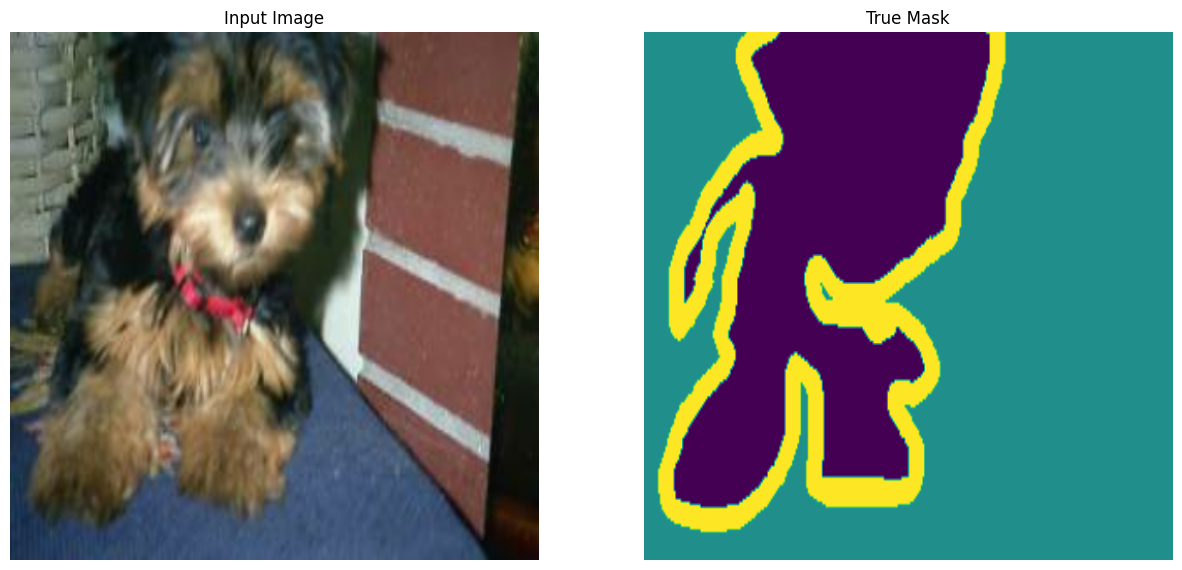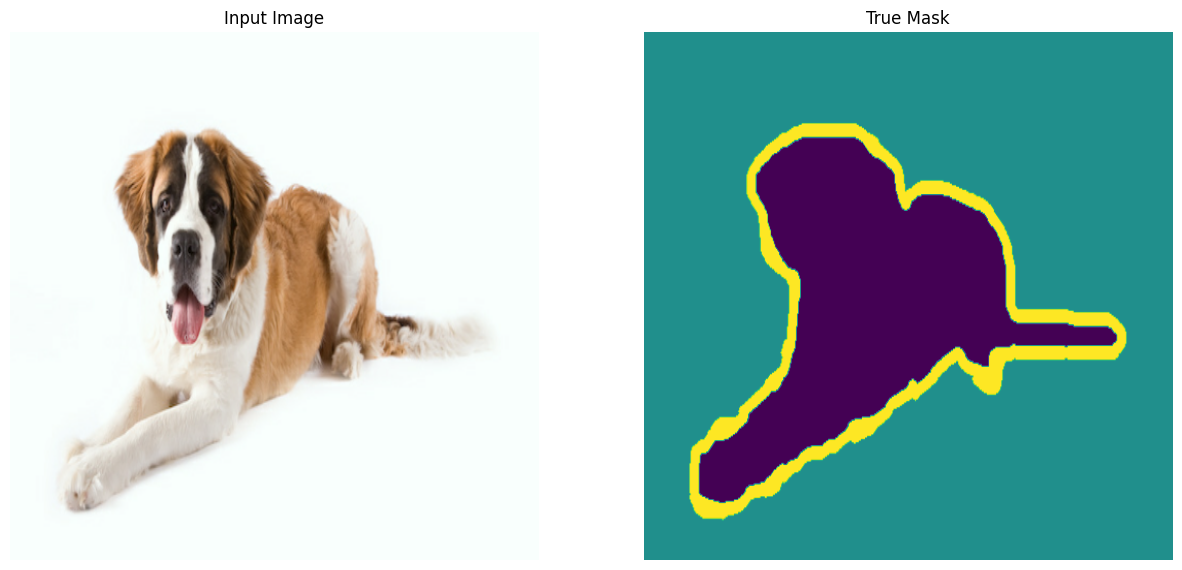使用 SegFormer 和 Hugging Face Transformers 进行语义分割
作者: Sayak Paul
创建日期 2023/01/25
最后修改日期 2023/01/29
描述: 微调 SegFormer 模型变体以进行语义分割。
引言
在此示例中,我们将展示如何微调 SegFormer 模型变体以在自定义数据集上执行语义分割。语义分割是为图像中的每个像素分配一个类别的任务。SegFormer 在 SegFormer: Simple and Efficient Design for Semantic Segmentation with Transformers 中被提出。SegFormer 使用分层 Transformer 架构(称为“Mix Transformer”)作为其编码器,并使用轻量级解码器进行分割。因此,它在语义分割上实现了最先进的性能,同时比现有模型更高效。欲了解更多详情,请查阅原始论文。

我们利用 Hugging Face Transformers 加载预训练的 SegFormer 检查点并在自定义数据集上进行微调。
注意:此示例重用了以下来源的代码
要运行此示例,我们需要安装 transformers 库
!!pip install transformers -q
[]
加载数据
我们在此示例中使用 Oxford-IIIT Pets 数据集。我们利用 tensorflow_datasets 加载数据集。
import tensorflow_datasets as tfds
dataset, info = tfds.load("oxford_iiit_pet:3.*.*", with_info=True)
/opt/conda/lib/python3.7/site-packages/tensorflow_io/python/ops/__init__.py:98: UserWarning: unable to load libtensorflow_io_plugins.so: unable to open file: libtensorflow_io_plugins.so, from paths: ['/opt/conda/lib/python3.7/site-packages/tensorflow_io/python/ops/libtensorflow_io_plugins.so']
caused by: ['/opt/conda/lib/python3.7/site-packages/tensorflow_io/python/ops/libtensorflow_io_plugins.so: undefined symbol: _ZN3tsl5mutexC1Ev']
warnings.warn(f"unable to load libtensorflow_io_plugins.so: {e}")
/opt/conda/lib/python3.7/site-packages/tensorflow_io/python/ops/__init__.py:104: UserWarning: file system plugins are not loaded: unable to open file: libtensorflow_io.so, from paths: ['/opt/conda/lib/python3.7/site-packages/tensorflow_io/python/ops/libtensorflow_io.so']
caused by: ['/opt/conda/lib/python3.7/site-packages/tensorflow_io/python/ops/libtensorflow_io.so: undefined symbol: _ZNK10tensorflow4data11DatasetBase8FinalizeEPNS_15OpKernelContextESt8functionIFN3tsl8StatusOrISt10unique_ptrIS1_NS5_4core15RefCountDeleterEEEEvEE']
warnings.warn(f"file system plugins are not loaded: {e}")
准备数据集
为了准备用于训练和评估的数据集,我们
- 使用 SegFormer 预训练期间使用的均值和标准差对图像进行归一化。
- 从分割掩码中减去 1,使像素值从 0 开始。
- 调整图像大小。
- 对图像进行转置,使其采用
"channels_first"格式。这是为了使其与 Hugging Face Transformers 中的 SegFormer 模型兼容。
import tensorflow as tf
from tensorflow.keras import backend
image_size = 512
mean = tf.constant([0.485, 0.456, 0.406])
std = tf.constant([0.229, 0.224, 0.225])
def normalize(input_image, input_mask):
input_image = tf.image.convert_image_dtype(input_image, tf.float32)
input_image = (input_image - mean) / tf.maximum(std, backend.epsilon())
input_mask -= 1
return input_image, input_mask
def load_image(datapoint):
input_image = tf.image.resize(datapoint["image"], (image_size, image_size))
input_mask = tf.image.resize(
datapoint["segmentation_mask"],
(image_size, image_size),
method="bilinear",
)
input_image, input_mask = normalize(input_image, input_mask)
input_image = tf.transpose(input_image, (2, 0, 1))
return {"pixel_values": input_image, "labels": tf.squeeze(input_mask)}
我们现在使用上述工具准备包含 prefetch() 以提高性能的 tf.data.Dataset 对象。更改 batch_size 以匹配您用于训练的 GPU 上的 GPU 内存大小。
auto = tf.data.AUTOTUNE
batch_size = 4
train_ds = (
dataset["train"]
.cache()
.shuffle(batch_size * 10)
.map(load_image, num_parallel_calls=auto)
.batch(batch_size)
.prefetch(auto)
)
test_ds = (
dataset["test"]
.map(load_image, num_parallel_calls=auto)
.batch(batch_size)
.prefetch(auto)
)
我们可以检查输入图像及其分割图的形状
print(train_ds.element_spec)
{'pixel_values': TensorSpec(shape=(None, 3, 512, 512), dtype=tf.float32, name=None), 'labels': TensorSpec(shape=(None, 512, 512), dtype=tf.float32, name=None)}
可视化数据集
import matplotlib.pyplot as plt
def display(display_list):
plt.figure(figsize=(15, 15))
title = ["Input Image", "True Mask", "Predicted Mask"]
for i in range(len(display_list)):
plt.subplot(1, len(display_list), i + 1)
plt.title(title[i])
plt.imshow(tf.keras.utils.array_to_img(display_list[i]))
plt.axis("off")
plt.show()
for samples in train_ds.take(2):
sample_image, sample_mask = samples["pixel_values"][0], samples["labels"][0]
sample_image = tf.transpose(sample_image, (1, 2, 0))
sample_mask = tf.expand_dims(sample_mask, -1)
display([sample_image, sample_mask])


加载预训练的 SegFormer 检查点
我们现在从 Hugging Face Transformers 加载一个预训练的 SegFormer 模型变体。SegFormer 模型有不同的变体,称为 MiT-B0 到 MiT-B5。您可以在此处找到这些检查点。我们加载最小的变体 Mix-B0,它在推理效率和预测性能之间取得了良好的权衡。
from transformers import TFSegformerForSemanticSegmentation
model_checkpoint = "nvidia/mit-b0"
id2label = {0: "outer", 1: "inner", 2: "border"}
label2id = {label: id for id, label in id2label.items()}
num_labels = len(id2label)
model = TFSegformerForSemanticSegmentation.from_pretrained(
model_checkpoint,
num_labels=num_labels,
id2label=id2label,
label2id=label2id,
ignore_mismatched_sizes=True,
)
WARNING:tensorflow:5 out of the last 5 calls to <function Conv._jit_compiled_convolution_op at 0x7fa8cc1139e0> triggered tf.function retracing. Tracing is expensive and the excessive number of tracings could be due to (1) creating @tf.function repeatedly in a loop, (2) passing tensors with different shapes, (3) passing Python objects instead of tensors. For (1), please define your @tf.function outside of the loop. For (2), @tf.function has reduce_retracing=True option that can avoid unnecessary retracing. For (3), please refer to https://tensorflowcn.cn/guide/function#controlling_retracing and https://tensorflowcn.cn/api_docs/python/tf/function for more details.
WARNING:tensorflow:5 out of the last 5 calls to <function Conv._jit_compiled_convolution_op at 0x7fa8cc1139e0> triggered tf.function retracing. Tracing is expensive and the excessive number of tracings could be due to (1) creating @tf.function repeatedly in a loop, (2) passing tensors with different shapes, (3) passing Python objects instead of tensors. For (1), please define your @tf.function outside of the loop. For (2), @tf.function has reduce_retracing=True option that can avoid unnecessary retracing. For (3), please refer to https://tensorflowcn.cn/guide/function#controlling_retracing and https://tensorflowcn.cn/api_docs/python/tf/function for more details.
WARNING:tensorflow:6 out of the last 6 calls to <function Conv._jit_compiled_convolution_op at 0x7fa8bde37440> triggered tf.function retracing. Tracing is expensive and the excessive number of tracings could be due to (1) creating @tf.function repeatedly in a loop, (2) passing tensors with different shapes, (3) passing Python objects instead of tensors. For (1), please define your @tf.function outside of the loop. For (2), @tf.function has reduce_retracing=True option that can avoid unnecessary retracing. For (3), please refer to https://tensorflowcn.cn/guide/function#controlling_retracing and https://tensorflowcn.cn/api_docs/python/tf/function for more details.
WARNING:tensorflow:6 out of the last 6 calls to <function Conv._jit_compiled_convolution_op at 0x7fa8bde37440> triggered tf.function retracing. Tracing is expensive and the excessive number of tracings could be due to (1) creating @tf.function repeatedly in a loop, (2) passing tensors with different shapes, (3) passing Python objects instead of tensors. For (1), please define your @tf.function outside of the loop. For (2), @tf.function has reduce_retracing=True option that can avoid unnecessary retracing. For (3), please refer to https://tensorflowcn.cn/guide/function#controlling_retracing and https://tensorflowcn.cn/api_docs/python/tf/function for more details.
Some layers from the model checkpoint at nvidia/mit-b0 were not used when initializing TFSegformerForSemanticSegmentation: ['classifier']
- This IS expected if you are initializing TFSegformerForSemanticSegmentation from the checkpoint of a model trained on another task or with another architecture (e.g. initializing a BertForSequenceClassification model from a BertForPreTraining model).
- This IS NOT expected if you are initializing TFSegformerForSemanticSegmentation from the checkpoint of a model that you expect to be exactly identical (initializing a BertForSequenceClassification model from a BertForSequenceClassification model).
Some layers of TFSegformerForSemanticSegmentation were not initialized from the model checkpoint at nvidia/mit-b0 and are newly initialized: ['decode_head']
You should probably TRAIN this model on a down-stream task to be able to use it for predictions and inference.
警告告诉我们,我们丢弃了一些权重并新初始化了一些其他权重。不要惊慌!这是完全正常的。由于我们使用的是自定义数据集,其语义类别标签集与预训练数据集不同,因此 TFSegformerForSemanticSegmentation 正在初始化一个新的解码器头。
我们现在可以初始化一个优化器并使用它编译模型。
编译模型
lr = 0.00006
optimizer = tf.keras.optimizers.Adam(learning_rate=lr)
model.compile(optimizer=optimizer)
No loss specified in compile() - the model's internal loss computation will be used as the loss. Don't panic - this is a common way to train TensorFlow models in Transformers! To disable this behaviour please pass a loss argument, or explicitly pass `loss=None` if you do not want your model to compute a loss.
请注意,我们没有使用任何损失函数来编译模型。这是因为当我们提供输入图像和标签时,模型的正向传播会实现损失计算部分。计算损失后,模型返回一个结构化的 dataclass 对象,然后用于指导训练过程。
使用已编译的模型,我们可以继续在其上调用 fit() 以开始微调过程!
用于监控训练进度的预测回调函数
它帮助我们在模型微调期间可视化一些样本预测,从而帮助我们监控模型的进度。此回调函数受到此教程的启发。
from IPython.display import clear_output
def create_mask(pred_mask):
pred_mask = tf.math.argmax(pred_mask, axis=1)
pred_mask = tf.expand_dims(pred_mask, -1)
return pred_mask[0]
def show_predictions(dataset=None, num=1):
if dataset:
for sample in dataset.take(num):
images, masks = sample["pixel_values"], sample["labels"]
masks = tf.expand_dims(masks, -1)
pred_masks = model.predict(images).logits
images = tf.transpose(images, (0, 2, 3, 1))
display([images[0], masks[0], create_mask(pred_masks)])
else:
display(
[
sample_image,
sample_mask,
create_mask(model.predict(tf.expand_dims(sample_image, 0))),
]
)
class DisplayCallback(tf.keras.callbacks.Callback):
def __init__(self, dataset, **kwargs):
super().__init__(**kwargs)
self.dataset = dataset
def on_epoch_end(self, epoch, logs=None):
clear_output(wait=True)
show_predictions(self.dataset)
print("\nSample Prediction after epoch {}\n".format(epoch + 1))
训练模型
# Increase the number of epochs if the results are not of expected quality.
epochs = 5
history = model.fit(
train_ds,
validation_data=test_ds,
callbacks=[DisplayCallback(test_ds)],
epochs=epochs,
)
1/1 [==============================] - 0s 54ms/step

Sample Prediction after epoch 5
920/920 [==============================] - 89s 97ms/step - loss: 0.1742 - val_loss: 0.1927
推理
我们对测试集中的几个样本执行推理。
show_predictions(test_ds, 5)
1/1 [==============================] - 0s 54ms/step

1/1 [==============================] - 0s 54ms/step

1/1 [==============================] - 0s 53ms/step

1/1 [==============================] - 0s 53ms/step

1/1 [==============================] - 0s 53ms/step

结论
在此示例中,我们学习了如何在自定义数据集上微调 SegFormer 模型变体以进行语义分割。为了简洁起见,此示例保持简短。但是,您可以进一步尝试以下几点
- 结合数据增强以潜在地改善结果。
- 使用更大的 SegFormer 模型检查点以查看结果如何受到影响。
- 将微调后的模型推送到 Hugging Face Hub 以便轻松与社区共享。您只需执行
model.push_to_hub("your-username/your-awesome-model")即可。然后您可以通过执行TFSegformerForSemanticSegmentation.from_pretrained("your-username/your-awesome-model")加载模型。此处是一个端到端示例,如果您正在寻找参考。 - 如果您更愿意在模型微调期间将模型检查点推送到 Hub,则可以使用
PushToHubCallbackKeras 回调函数。此处是一个示例。此处是一个使用此回调函数创建的模型仓库示例。